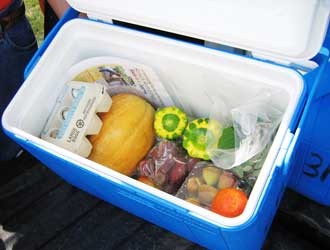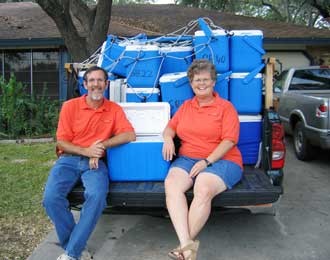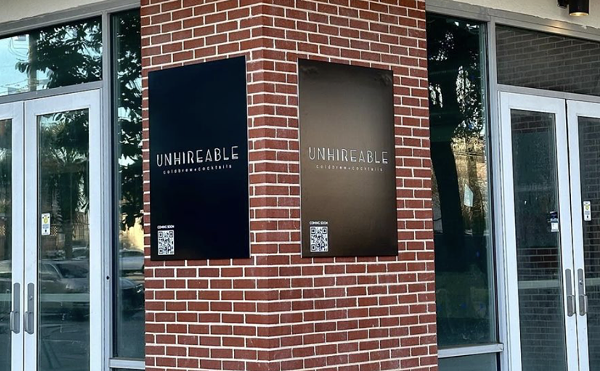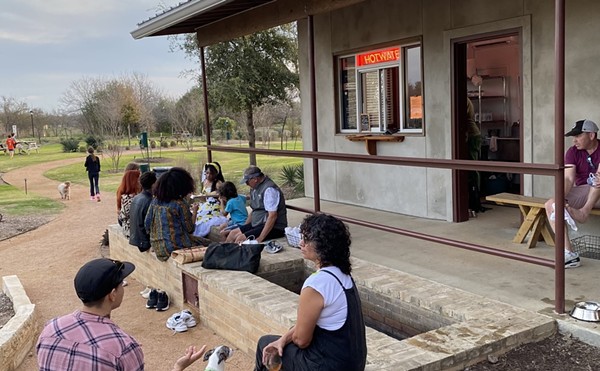At Rancho de la Chuparrosa, the Community Supported Agriculture program lends a hand on the farm in return for fresh produce
On Saturday mornings, Rancho de la Chuparrosa can be found in the farmers’ markets at Madhatter’s Teahouse and Artisans Alley, selling its vegetables, chicken, and locally produced beef. Earlier in the summer, my husband and I arrived at Madhatter’s at a worm-catching hour, only to find that we were too late. The pickings were beautiful but slim: a few baskets of tomatoes, lemon cucumbers, onions, and carrots. The seller, Matt Hansen, informed us that first choice of the farm’s production goes to its Community Supported Agriculture program, and whatever remains goes to market.
| Robin Bowman holds Islander and Krimson Lee peppers (top) in her palm, a portion of the weekly cooler of vegetables (middle) she and her husband, Peter, deliver to members of Rancho de la Chuparrosa’s Community Supported Agriculture program. This week’s delivery includes starburst squash, a half dozen eggs, rayanne melon, lambs quarter, figs, and prickly pear. Below: Although Robin is the farmer in the family, Peter, a contractor, works on the farm as often as he can. (Photos by Susan Pagani) |
A CSA is a cooperative program in which people interested in local agriculture essentially join a farm, commiting to share the costs of supporting a farm and the risk of variable crops. While CSAs are increasingly common in Texas — there are two in San Antonio, including Chuparrosa, and approximately 25 statewide, with the bulk clustered around Austin and Dallas — they are more established along the East and West coasts, and the Great Lakes. For example, New York boasts 106, Wisconsin 70, and California 81.
The Chuparrosa’s CSA has 24 members, and another 12 on the waiting list. Members pay $957 annually ($18.40 a week) and commit to working 16 hours a year on the farm, and, in exchange, they get a box of fresh produce each Friday. Last week, the box contained tomatoes, peppers, cucumbers, squash, eggplant, lamb’s quarter, figs, spaghetti squash, prickly pears, and a harvest newsletter with recipes. “We’re big on recipes,” says Robin Bowman, farmer and owner of Chuparossa. “The first week we had the prickly pears we sent along four pages — how to peel, juice, and puree them — because they’re a little unusual.”
Bowman and her husband bought the Chuparrosa, an old cattle ranch in Sabinal, seven years ago as a weekend retreat from San Antonio, but Bowman soon discovered she didn’t want to go home on Monday. Although she hadn’t intended to farm the land, Bowman built a couple of tractors — long, portable, hen houses — and experimented with raising chickens for a couple of years. In 2000, she put in her first crop of vegetables.
Bowman says she had the farm certified organic for one year prior to the creation of the USDA standards. Like many organic farmers, she feels the USDA has eased restrictions to make room for large corporations, so the symbol is less meaningful, and certification isn’t necessarily beneficial for her business. “For me it’s a marketing decision,” she explains. “If we sold to Whole Foods or Central Market we would really have to be certified. But because we sell directly to our customers they can be our inspectors; they can come and see the farm, talk with us about our practices, and see for themselves.”
What they’ll see are chickens and turkeys pastured in a large, portable yard. Bowman sells the broilers and raises the hens for eggs. She keeps a few roosters to fertilize the eggs, and the extras she sells to local chefs for coq au van, a recipe that calls for gamey old rooster meat. They’ll also see drip-irrigated vegetables grown without chemical pesticides or non-organic fertilizers, and with a lot of mulch and compost to encourage the plants to absorb nutrients. “Microbes in the soil allow the plants to take up the nutrients,” Bowman says. “Pesticides kill the microbes and, without them, you can have a great looking tomato that has no nutritional value, it’s not doing anything for your body.”
Bowman’s reasons for starting the CSA are as practical as they are philosophical. Farmers’ markets, she says, are too variable to sustain a small farm. “Some weeks everyone is there, some weeks nobody. I wanted a more stable income for the farm and the support of a community.”
Anna Henry has been a member of the Chuparrosa CSA for two years, and, prior to that, she belonged to CSAs in Minnesota and Wisconsin. “I believe in supporting community agriculture,” she says. “I feel more connected to the earth and healthy when I eat organic food, and food that is harvested with the seasons.”
She’s been eating with the harvest long enough now that her body knows what’s in season. “It would be ridiculous to buy an acorn squash in the winter or spring, but around September or October, I’ll start craving one.”
Bowman says the CSA has also been a “boon” because of the workdays, which not only help members bond with the farm, but also help tremendously with labor, her biggest challenge. CSA members do whatever needs to be done: weed, plant, collect eggs, butcher chickens, mulch, and harvest vegetables. Sometimes a group of families will come out and camp on the farm overnight, pitching tents and roasting marshmallows, and work the next day. “I have more of a sales background,” says Henry, who just quit her job as a pharmaceutical rep to start a pet-sitting business. “So I go to the farmers’ markets and sell whatever Chuparrosa brings to market.”
When the crops are healthy, Bowman estimates the value of the weekly vegetable box at between $24 and $49, depending on what’s in season. However, the annual CSA fees are an investment in the farm, and if the crops fail members don’t receive a refund. Last year, floods knocked out all the vegetable beds, and it took Bowman three months to produce another crop. This year, natural predators — foxes, raccoons, coyotes, owls, and opossums — killed 800 of her hens. “The saddest thing was having people come by for their eggs,” says Bowman. “We have standing orders for 180 dozen eggs a week. People will drive 30 or 40 miles to get good eggs, not having any to sell them was a financial hardship, but it was also really emotional.”
When the Chuparrosa’s crops failed, Henry went to Whole Foods and bought organic produce, “which was expensive, but supporting the farm is taking a risk. Sometimes it’s so bountiful we are eating like kings and queens — I like to think it balances out.”
That support, says Bowman, is crucial. Last year was bad, but it was “tremendously helpful” that she could turn to the CSA as an advisory board, and more established CSA farmers also provided advice and support. “It is really nice to have a team pulling for you. You know, when we lost the hens, we got so many phone calls and e-mails, they were really rooting for us, they felt our pain,” Robin says. “I’m really glad we formed the CSA. Whatever else happens, we know we’ve got that foundation.” •
To learn more about Rancho de la Chuparrosa, go to goodfoodfarm.com
By Susan Pagani




















